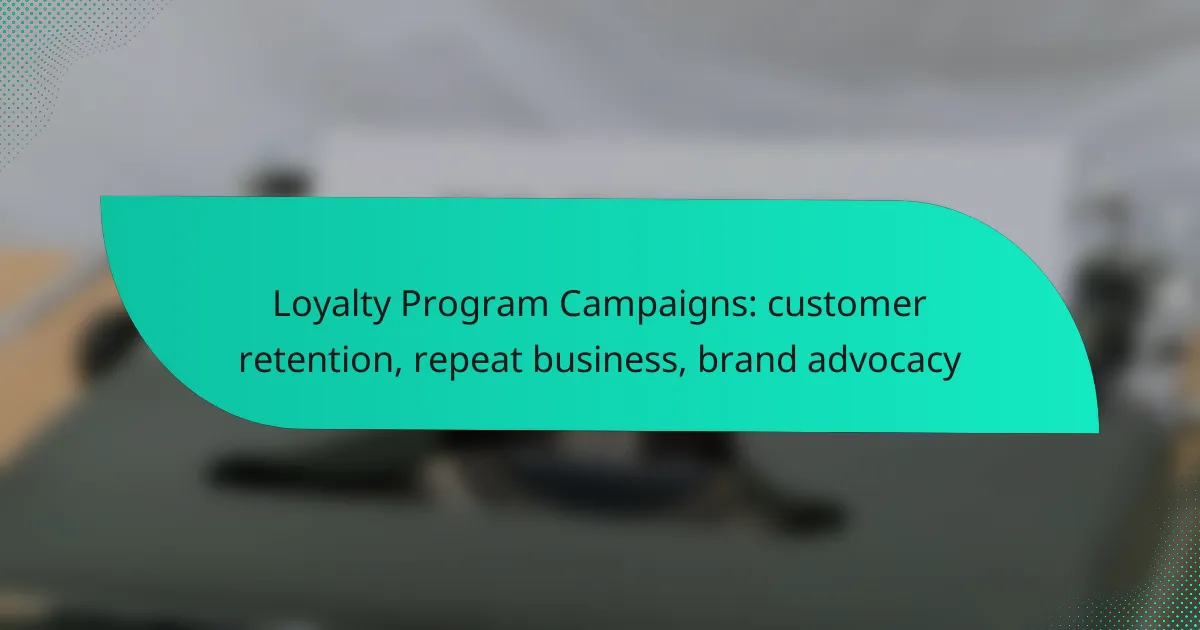Loyalty programs play a crucial role in enhancing customer retention by incentivizing repeat purchases and cultivating brand loyalty. By offering rewards and exclusive benefits, these programs create a sense of belonging that encourages customers to return. Additionally, effective strategies not only drive repeat business but also foster brand advocacy, as satisfied customers are motivated to share their positive experiences with others.

How do loyalty programs enhance customer retention in the UK?
Loyalty programs significantly boost customer retention in the UK by incentivizing repeat purchases and fostering brand loyalty. These programs create a sense of belonging among customers, encouraging them to return for rewards and exclusive offers.
Increased customer engagement
Loyalty programs enhance customer engagement by providing frequent interactions through rewards and promotions. Customers are more likely to engage with brands that recognize their loyalty, leading to higher participation in marketing campaigns and events.
For example, a coffee shop might offer a free drink after a certain number of purchases, prompting customers to visit more often. This consistent engagement helps maintain a strong relationship between the brand and its customers.
Personalized rewards
Personalized rewards are crucial in loyalty programs, as they cater to individual customer preferences and behaviors. By analyzing purchase history, brands can tailor rewards that resonate with their customers, making them feel valued.
For instance, a clothing retailer might offer discounts on items similar to past purchases, increasing the likelihood of repeat business. This personalization not only enhances customer satisfaction but also drives higher sales conversions.
Data-driven insights
Loyalty programs provide valuable data-driven insights that help businesses understand customer behavior and preferences. By tracking engagement and redemption patterns, brands can refine their offerings and marketing strategies to better meet customer needs.
For example, if data shows that customers prefer certain types of rewards, businesses can adjust their programs accordingly. This approach not only improves customer retention but also optimizes marketing spend, ensuring resources are directed where they are most effective.

What are effective loyalty program strategies for repeat business?
Effective loyalty program strategies for repeat business focus on creating value for customers while encouraging them to return. These strategies can enhance customer retention, foster brand advocacy, and ultimately drive repeat purchases.
Tiered rewards systems
Tiered rewards systems incentivize customers to spend more by offering different levels of rewards based on their spending. For example, a customer might earn basic rewards for spending up to $100, but unlock premium benefits once they exceed $500. This structure encourages customers to aim for higher tiers to enjoy better perks.
When implementing a tiered system, consider setting clear thresholds and benefits that resonate with your target audience. Common rewards include discounts, exclusive products, or early access to sales. Ensure that the benefits are appealing enough to motivate customers to increase their spending.
Referral bonuses
Referral bonuses reward existing customers for bringing in new ones, effectively leveraging word-of-mouth marketing. For instance, a customer might receive a discount or credit for each friend they refer who makes a purchase. This not only retains current customers but also attracts new ones.
To maximize the effectiveness of referral bonuses, make the process simple and rewarding. Offer attractive incentives for both the referrer and the new customer, such as a percentage off their next purchase. Monitor the program’s performance to adjust incentives as needed to keep it appealing.
Exclusive member events
Exclusive member events create a sense of community and belonging among loyal customers. These events can range from private sales to special gatherings, such as product launches or workshops. By inviting only loyalty program members, brands can enhance the perceived value of membership.
When planning these events, consider the interests of your customer base to ensure high engagement. Offering unique experiences, such as behind-the-scenes access or meet-and-greets with key figures, can significantly boost customer loyalty. Promote these events through targeted communications to maximize attendance and excitement.

How can loyalty programs drive brand advocacy?
Loyalty programs can significantly enhance brand advocacy by encouraging customers to share their positive experiences and recommend the brand to others. By rewarding customers for their loyalty, businesses can foster a community of advocates who actively promote the brand through various channels.
Social media sharing incentives
Incentivizing social media sharing is an effective way to drive brand advocacy through loyalty programs. Offering rewards, such as discounts or exclusive offers, for customers who share their purchases or experiences on platforms like Instagram or Facebook can amplify brand visibility. For example, a brand might provide a 10% discount on the next purchase for every social media post that tags the brand.
To maximize engagement, ensure that the sharing process is simple and encourages creativity. Consider using specific hashtags or themes that align with your brand identity, making it easier for customers to participate and for others to discover your brand.
Customer testimonials and reviews
Encouraging customers to provide testimonials and reviews can strengthen brand advocacy and enhance credibility. Loyalty programs can offer points or rewards for submitting reviews, which not only motivates customers to share their experiences but also generates valuable content for your marketing efforts. For instance, a customer might earn points for writing a detailed review on a product page or sharing a success story on the brand’s website.
To effectively leverage testimonials, showcase them prominently on your website and social media channels. Highlighting authentic customer experiences can influence potential buyers and build trust in your brand. Additionally, consider responding to reviews to foster a sense of community and show appreciation for customer feedback.

What are the key metrics for measuring loyalty program success?
The key metrics for measuring loyalty program success include customer lifetime value, retention rates, and redemption rates. These metrics help businesses understand the effectiveness of their loyalty initiatives and identify areas for improvement.
Customer lifetime value
Customer lifetime value (CLV) is a projection of the total revenue a business can expect from a single customer throughout their relationship. To calculate CLV, consider the average purchase value, purchase frequency, and customer lifespan. For example, if a customer spends $100 per purchase, buys twice a year, and remains loyal for five years, their CLV would be $1,000.
Monitoring CLV helps businesses allocate resources effectively and tailor loyalty programs to enhance long-term profitability. Aim for a CLV that is at least three times higher than the cost of acquiring a new customer to ensure sustainable growth.
Retention rates
Retention rates measure the percentage of customers who continue to engage with a brand over a specific period. A high retention rate indicates that customers find value in the loyalty program and are likely to make repeat purchases. Businesses should aim for a retention rate of at least 60-70% to maintain a healthy customer base.
To improve retention rates, regularly assess customer feedback and adjust loyalty offerings accordingly. Implementing personalized rewards and communication can significantly enhance customer satisfaction and loyalty.
Redemption rates
Redemption rates reflect the percentage of rewards that customers actually redeem compared to those earned. A high redemption rate indicates that customers are engaged and find the rewards appealing. Generally, a redemption rate between 20-30% is considered effective, but this can vary based on the type of rewards offered.
To optimize redemption rates, ensure that rewards are attainable and relevant to your customer base. Avoid overly complex redemption processes, as simplicity encourages participation and enhances customer experience.

What prerequisites should businesses consider before launching a loyalty program?
Before launching a loyalty program, businesses should assess their customer base, budget, and overall strategy. Understanding these factors ensures that the program aligns with customer expectations and company goals.
Target audience analysis
Identifying the target audience is crucial for a successful loyalty program. Businesses should analyze customer demographics, purchasing behavior, and preferences to tailor rewards that resonate with them. For instance, a coffee shop might find that frequent visitors prefer discounts on drinks, while occasional customers might appreciate free items after a certain number of purchases.
Utilizing surveys or customer feedback can provide valuable insights into what incentives would motivate repeat business. Segmenting the audience into groups can also help in creating personalized experiences that drive brand advocacy.
Budget allocation
Allocating a budget for a loyalty program is essential to ensure its sustainability. Businesses should consider the costs associated with rewards, marketing, and technology needed to manage the program. A common approach is to allocate a percentage of projected sales to the loyalty initiative, typically ranging from 5% to 10% for small to medium-sized businesses.
It’s important to balance the budget with expected returns. Tracking the program’s performance through metrics like customer retention rates and average transaction value can help refine budget allocations over time. Avoid overspending on rewards that do not yield significant customer engagement or loyalty.

How do different industries implement loyalty programs?
Industries implement loyalty programs in various ways to enhance customer retention and encourage repeat business. These programs often include rewards, discounts, and exclusive offers tailored to the specific needs and behaviors of their customer base.
Retail
In the retail sector, loyalty programs typically reward customers for repeat purchases with points that can be redeemed for discounts or free products. Many retailers use tiered systems where customers unlock greater rewards as they spend more, incentivizing higher spending.
For example, a clothing store might offer a point for every dollar spent, allowing customers to redeem 100 points for a $10 discount. Retailers should consider integrating mobile apps to track points and provide personalized offers based on shopping habits.
Hospitality
The hospitality industry often employs loyalty programs that reward frequent guests with perks such as free nights, room upgrades, or exclusive access to events. These programs are designed to build brand loyalty and encourage repeat stays.
For instance, a hotel chain might offer members a free night after accumulating a certain number of stays. It’s essential for hospitality businesses to communicate these benefits clearly and ensure a seamless experience for loyalty members.
Food and Beverage
Restaurants and cafes frequently use loyalty programs that offer rewards for repeat visits, such as a free drink after a set number of purchases. These programs can be implemented through punch cards or mobile apps that track customer purchases.
For example, a coffee shop might provide a free coffee after ten purchases. Establishments should focus on making the rewards attainable and relevant to encourage ongoing patronage.
Travel
Travel companies, including airlines and car rental services, often have loyalty programs that reward customers with points for every dollar spent, which can be redeemed for free flights, upgrades, or discounts on future bookings. These programs are crucial for retaining customers in a competitive market.
For instance, an airline might offer miles for each flight taken, which can be used for free tickets or upgrades. Travel companies should ensure their programs are easy to understand and provide clear value to frequent travelers.
Financial Services
In the financial services sector, loyalty programs often reward customers for using specific products or services, such as credit cards or bank accounts. Rewards may include cashback, points redeemable for travel, or lower fees.
For example, a credit card company might offer 1% cashback on all purchases, with additional bonuses for spending in certain categories. Financial institutions should ensure that their loyalty offerings align with customer preferences and spending habits to maximize engagement.
